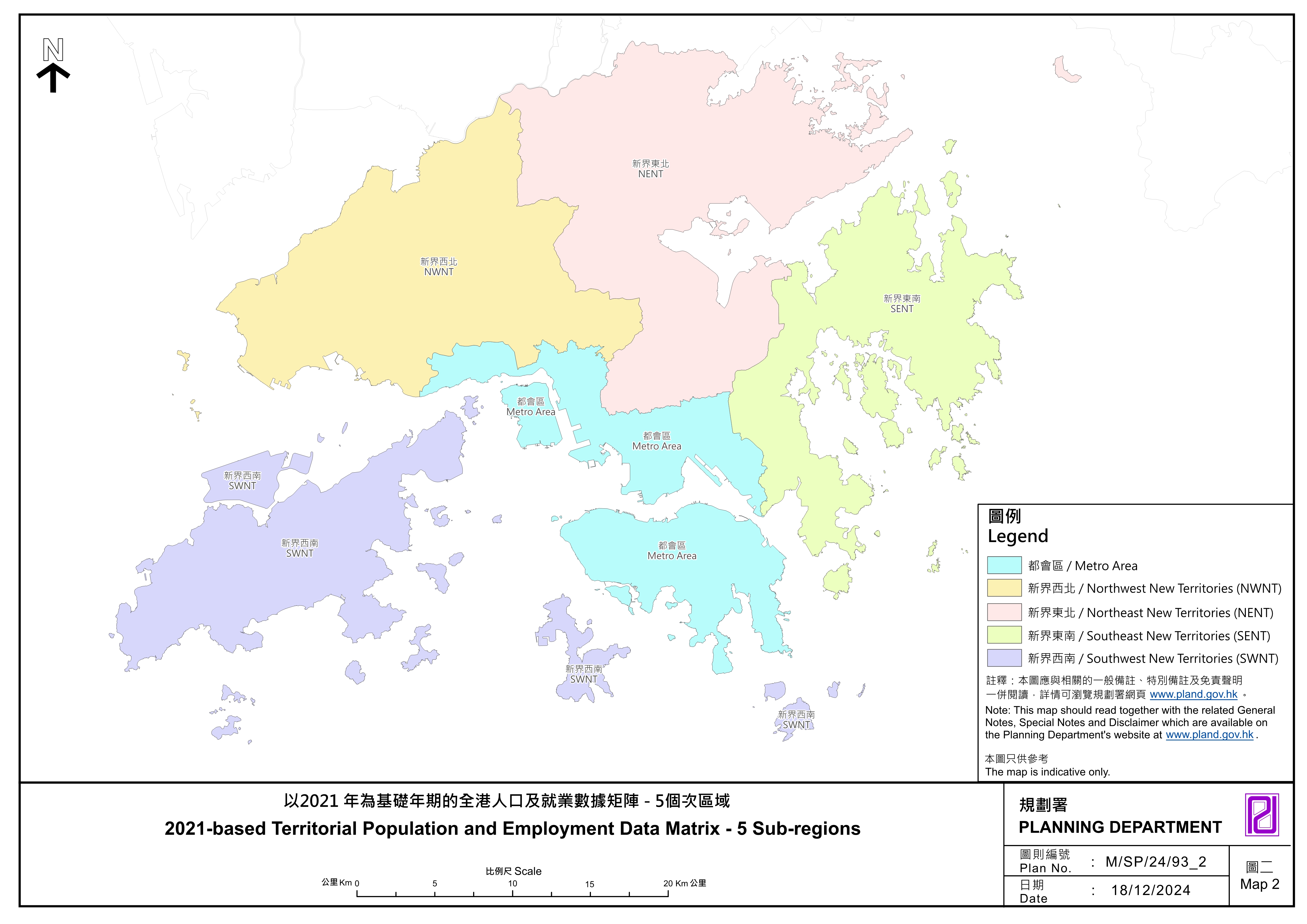2021–based Territorial Population and Employment Data Matrix
GENERAL NOTES :
-
The Territorial Population and Employment Data Matrix (TPEDM) is compiled by the Planning Department and updated regularly to tie in with the updated population projections of the Population Census. It provides estimated data on territorial distributions of population and employment in the future years for use as reference materials by government departments and stakeholders involved in the planning of developments and services.
-
The 2021-based TPEDM was completed in 2024 by adopting the Census and Statistics Department's projections of territorial population released in August 2023 as the control totals. It includes the population and employment estimates for the base year (i.e. 2021) and the projections for two future years (i.e. 2026 and 2031). The population and employment data is presented in 18 District Council Districts and 5 Sub-regions as shown on Map 1 and Map 2.
-
TPEDM was compiled using different assumptions regarding future territorial population, employment structure, economic growth as well as the planned and latest known development proposals of relevant Government departments, quasi-government bodies and the private sector. The assumptions on future development may be subject to change after the compilation.
SPECIAL NOTES :
Population Coverage
-
The population of 2021-based TPEDM refers to land-based Hong Kong Resident Population (HKRP). HKRP comprises “Usual Residents” and “Mobile Residents”, and foreign domestic helpers are included.
-
“Usual Residents” refer to two categories of people: (i) Hong Kong Permanent Residents who have stayed in Hong Kong for at least 3 months during the 6 months before or for at least 3 months during the 6 months after the reference time-point, regardless of whether they are in Hong Kong or not at the reference time-point; and (ii) Hong Kong Non-permanent Residents who are in Hong Kong at the reference time-point.
-
For those Hong Kong Permanent Residents who are not “Usual Residents”, they are classified as “Mobile Residents” if they have stayed in Hong Kong for at least 1 month but less than 3 months during the 6 months before or for at least 1 month but less than 3 months during the 6 months after the reference time-point, regardless of whether they are in Hong Kong or not at the reference time-point.
-
- Geographical distribution of population is generally made on the basis of place of residence. Accordingly, population of a particular area is made up of persons who live there.
Employment Coverage
-
Employment refers to the total number of full or part time jobs with establishments in Hong Kong. Positions taken up by working proprietors, self-employed, temporary employees as well as foreign domestic helpers are included. Jobs with establishments outside Hong Kong are excluded.
-
Employment is measured by the number of jobs held. Thus, a person holding more than one job will be counted separately. On the other hand, job vacancies are excluded.
-
Geographical distribution of employment is generally made on the basis of place of jobs. Accordingly, employment of a particular area is made up of number of jobs there.
Geographical Demarcation Systems
-
This version of 2021-based TPEDM presents estimates and projections of population and employment distribution at two levels of a geographical demarcation system, namely District Council District (DCD) and Sub-region.
District Council District (DCD)[1]
-
At the DCD level, the data are grouped and presented in respect of 18 DCDs boundaries (see Map 1) to facilitate population and employment data extraction for land use and public facilities planning in District Council level.
[1] The Loop Area is currently not included in a DCD, its figures are included in Yuen Long District.
Sub-region
-
The whole territory of Hong Kong can also be divided into five Sub-regions (see Map 2), namely Metro Area, Northwest New Territories (NWNT), Northeast New Territories (NENT), Southeast New Territories (SENT) and Southwest New Territories (SWNT).
DISCLAIMER
Many detailed working assumptions are involved in compiling the 2021-based TPEDM, changes to which may yield very different results. Although the Planning Department has endeavoured to adopt the best assumptions and data sources available at the time of producing the 2021-based TPEDM, persons making reference to the data therein should decide on the applicability of the data to any specific purpose or use. The Government is not to be held liable for any consequences arising from using the data.
Please click [Pdf format] [Excel format] [CSV format] to download the distributions of population and employment in 2021, 2026 and 2031 under the 2021-based TPEDM.
Planning Department
December 2024


